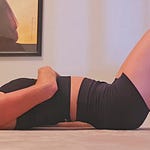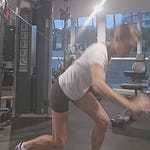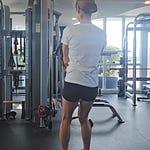Hey Beth -
What if I cannot bend my back without pain? How will I strengthen my abdominals?
The inability to bend the low back (lumbar flexion) presents some challenges to strengthening the abdominals and is where Postural Restoration (PRI) and Dynamic Neuromuscular Stabilization (DNS) make a huge difference.
When the left hip tilts forward it turns the lower portion of the spine (L3-S1) to the right. As the brain senses the turn to the right the body leans back to the left. This causes the upper portion of the low back to straighten and angle back toward the left (this also causes a curvature in the upper back simulating a scoliosis). The low back then looks like a forward slash on top of a parenthesis symbol.
In the body it looks like this -
Note the convex bend toward the right of the area just above and below the belly button and then the straight line above the belly button angling off to the left.
This pelvis position is the center of mass shift over the right hip (Left AIC pattern) that requires repositioning of the pelvis before abdominal strengthening. There are also several lying positions, bolstered by pillows, that help guide the pelvis and spine back to a central position.
Once repositioned the injured disc(s)/nerve(s) decompress and then can heal and abdominal strengthening can begin.
Flexion Issue Abdominal Training
Lie comfortably on your back
Inhale deeply through your nose expanding your low ribs and waist
Pause and lift your knees over your hips. The breath in will stabilize the low back and pelvis preventing the use of the hip flexors stabilizing the spine
Exhale and draw your belly button in as much as you can pressing your low back into the floor
Try to pull your pelvic bone up toward your belly button. The entire stomach should remain flat (contraction of the deep abdominal wall) and pull in tight (not ‘pop’ up in the middle - rectus abdominis)
This is not a big movement - Instead very small as the tailbone lifts off the floor
Inhale through the nose again and relax the deep abdominal wall
As you get stronger you can try to gently lift the sacrum straight up. This will press and keep the low back flat protecting the injured area not causing any pain and allow you to strengthen the deep abdominal wall (transversus ab).
The deep abdominal wall is essential for pelvis and low back stabilization during exhalation (fascial attachment to the low back to maintain disc height and connection to the pelvis)
Spine flexion at the lowest part (from L3 to S1) is essential for spine decompression and health.















Share this post